Table of Contents
Abstract
How do I get Mother Earth to help me heat my Home? To find the answer pay attention to what I am about to tell you.
Geothermal Energy
The word Geo comes from the Greek meaning the earth. The word thermal refers to heat, and Energy is Exertion of vigor or power So Geothermal Energy is
Geothermal energy is heat that is generated within the Earth. It is a renewable resource that can be harvested for human use. Geothermal Energy
Iceland is experiencing geothermal energy today in the form of a volcanic eruptions. Hot liquid rock is bubbling up from the earth.
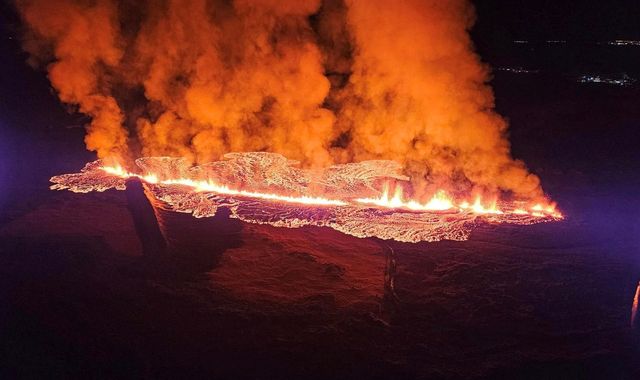
Somehow I do not think you would be interested in heating your home with volcanic rock. Although 90% of the buildings in iceland are heated with hot water from the earth.
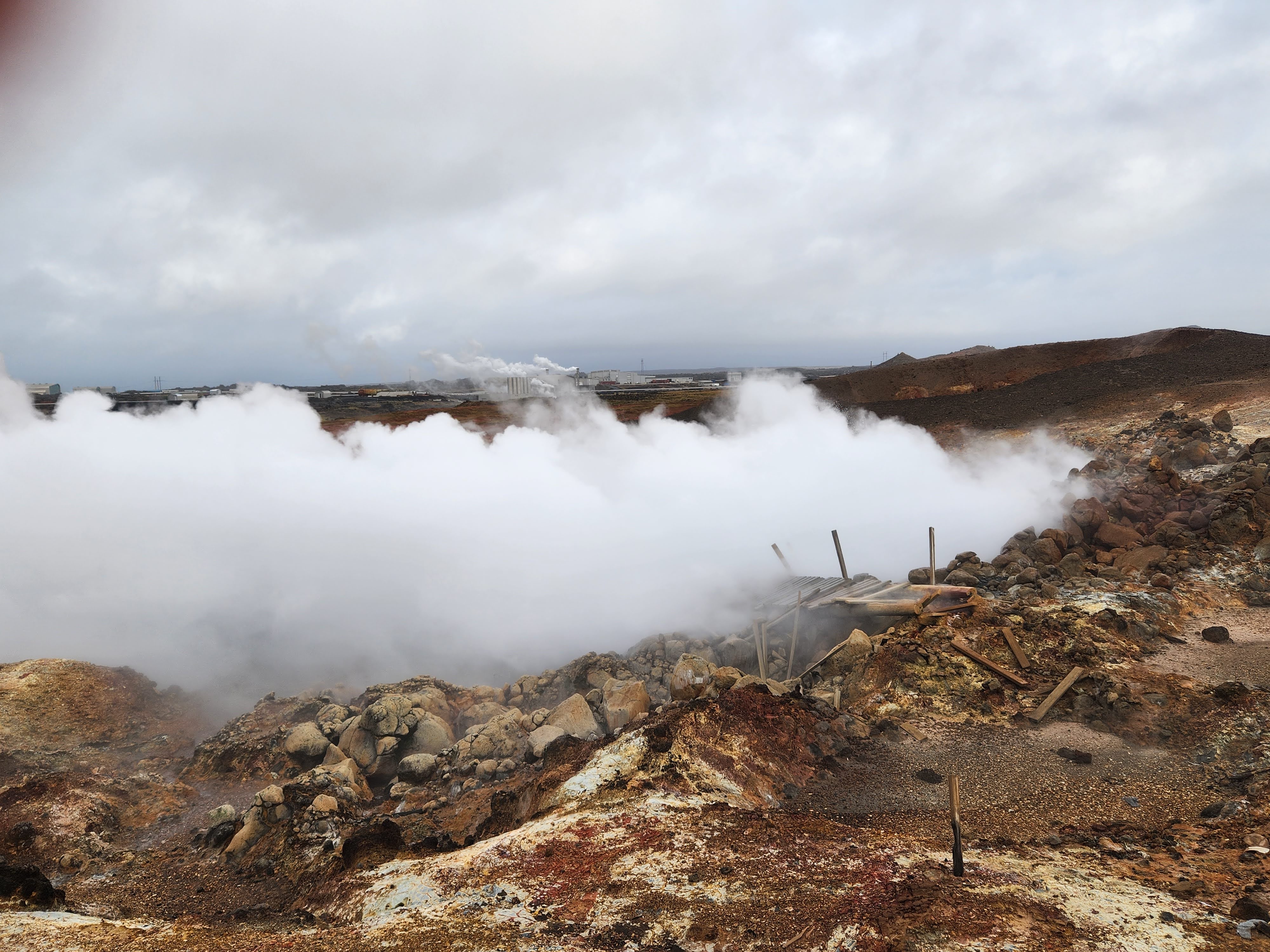
Iceland
Since we are talking about iceland lets pause a minute to discuss what the Icelanders take for granted.
The core of our planet is made up liquid rock. This is similar to the material we see coming from the volcano, on our light bulb in the sky, the sun.
In Iceland the molten rock is so close to the surface that water soaking through the rock is heated to produce steam. The steam pushes water up from beneath the ground in the form of bubbling hot water.
Deildartunguhver, hot spring
Obviously having one of these hot springs in the neighborhood would make heating our homes much simpler. But unless you plan on moving to iceland, this is not a workable solution.
Deep Geothermal Heat Research
On a visit to Cornell in 2022 I learned about a project they were pursuing to learn if they could use the earth’s heat to warm the campus. The details can be found in the web site: Deep Geothermal Heat Research. But I thought you might enjoy this introduction to the project.
Unfortunately this method of home heating is not available to us or others yet. If this research pans out it could provide an almost unlimited source if free energy anywhere in the world. But for now it is a research project.
GeoExchange
Recently I read an article in the New York Times about how universities are investing in using Geo energy to heat and cool the building on campuses.
Rather than repeat what I read in the article, I have reproduced a copy of the article. To Slash Carbon Emissions, Colleges Are Digging Really Deep
Geothermal Heating
So the question you would all like to know is how can I tap into these heat sources to warm and cool my home.
I am afraid that getting hot water from Iceland would be a little impractical. The idea of having your own back yard bore hole is not yet practical, so how can you get heat from the earth for your home.
Before we discuss geothermal heating, lets take a side trip to upderstand how air conditioning works. The principle behind air conditioning is the method used in geothermal heating and cooling.
The Air Conditioner
Before we get to heating, we need to understand how air conditioning works. If you have ever blown air across a cold object you will notice the air is cooled when it passes over the cold surface. Lets have a brief look at the history of the air conditioner.
Air Conditioning History
University of Glasgow professor William Cullen evaporated liquids in a vacuum thus creating refrigeration technology as early as 1748.
More than 100 years after that, John Gorrie, a Florida doctor, used a small steam engine to cool air so that his patients suffering from tropical illnesses could be more comfortable. Gorrie called his invention an “ice machine.” New machinery that could produce cool temperatures would seem like an exciting proposition during the Industrial Revolution, but Gorrie’s efforts to patent and popularize his invention were thwarted. Northern icemakers who profited from shipping ice to the South lobbied against Gorrie and benefited from a public skeptical of the artificially cooled air produced by Gorrie’s ice machine.
“That system was so revolutionary that he died penniless. He simply couldn’t get anyone to believe that it worked,” Basile says.
Then along came
Willis Carrier, a 25-year-old experimental engineer, created a primitive cooling system to reduce humidity around the printer. He used an industrial fan to blow air over steam coils filled with cold water; the excess humidity would then condense on the coils and produce cooled air.
“Not only did it solve the problem, but [the cool air] started to make people comfortable, and then the lightbulb went off,” Basile says. The Unexpected History of the Air Conditioner
How does the Air Conditioner work
So now we know how to cool you when the weather is hot. But how can you warm up when the air is cold?
Heat Pump
We have seen how to cool your house compressing and decompressing a gas in an air conditioner. But, aside from moving the compressor and evaporator around, maybe we can reverse the two operations in the winter.
How does the Heat Pump work
Up to this point we have been using air on both ends of the system to heat and cool. What do you think would happen if we put one set of coils under water?
Geothermal in my home
Now I know you are all curious about how installing a geothermal system went in my home. Well it is still a work in progress, but it looks like it will work well.
Background
First a little background about my home and experience with air conditioning.
My home was build back in 1973. It is a 5 bedroom, 3 bath contemporary ranch house, with a finished basement. When we bought the house it had base board hot water heating and no air conditioning.
Let me show you a floor plan of the upper story of my house so the discussion will make more sense.
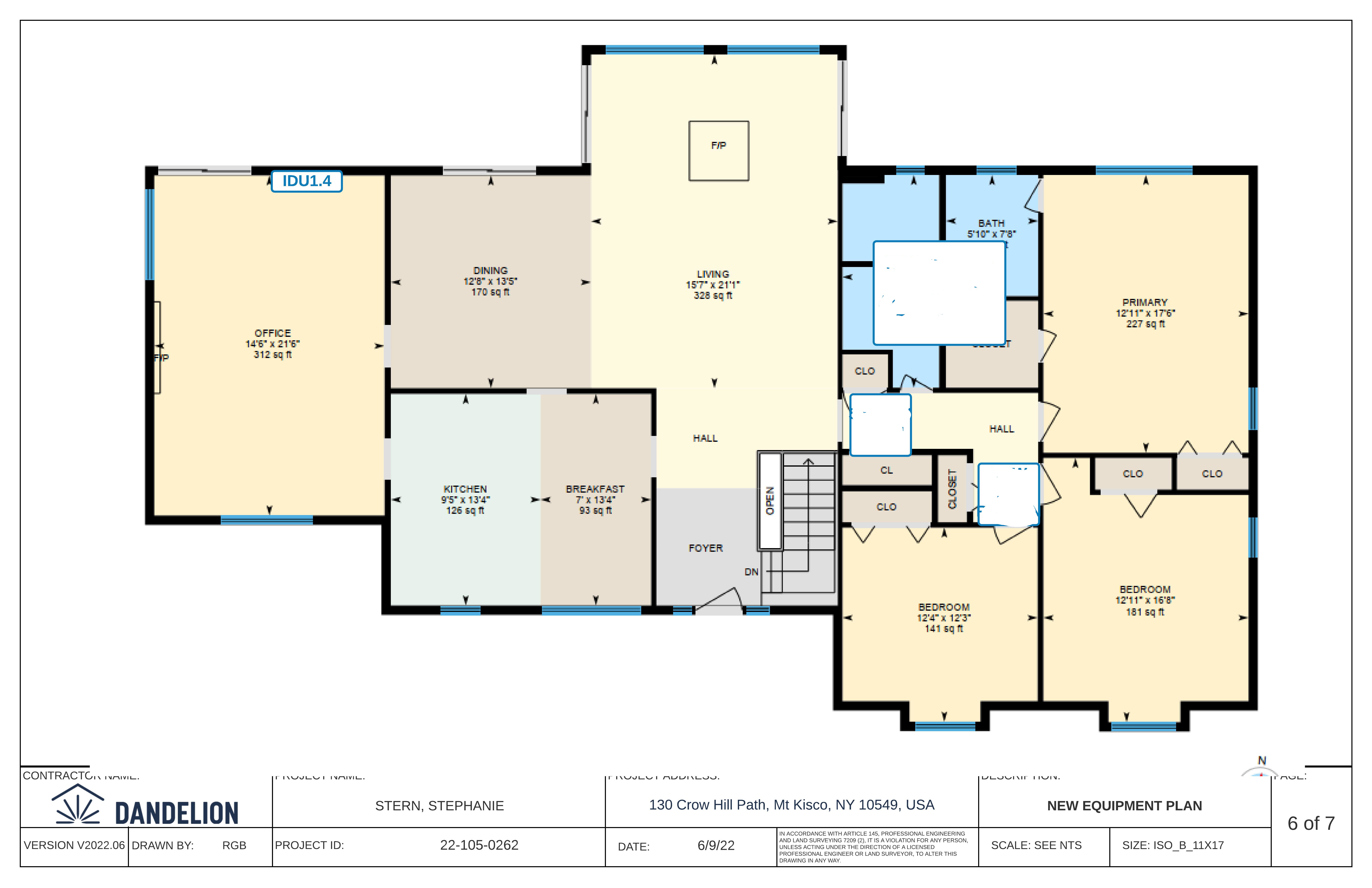
Air Conditioning
In 1989 we installed central air using 2 - 6 ton units. One on each end of the house in the attics. We did not air condition the basement because is did not need it.
This system worked OK, except the unit over the bedrooms had ducts in both the bedrooms and the living room. The thermostat was in the hallway to the bedrooms. This made the control difficult because it was driving two spaces with different cooling needs. I played with the settings for many years to get it to work acceptably, but it was never right.
Then in about 2016 a tree fell on the air conditioner over the bedrooms. So instead of replacing the air conditioner with another air conditioner, we installed a heat pump.
Air Source Heat Pump
In 2018 we installed an air source heat pump. I looked at geothermal heat pumps, but the price was too high at the time. I also asked one of the companies bidding in the heat pump if we really needed 2 - 6 ton units.
Manual J
This is a tool used by HVAC pros to calculate how much heating and cooling you need for a given space. A full Manual J calculation can be quite complex, but you can try using something similiar at Building Energy Optimization Tool from the National Energy Department to see what might work.
I had done a calculation for a Manual J using free software, but did not trust myself to get it right. So I asked one of the people bidding on the heat pump to do another one. Turns out we only needed a single 6 ton unit for the whole floor. So with that in mind, we bid on installing a 6 ton unit, with 2 zones. One for the bedrooms, and one for the living room. We did add a 3/4 ton heat pump for the library on the end of the house, since it was so far from the main unit.
That system worked fine, except when the outside temperatures was above 95 degrees, or below 40 degrees. Air source heat pumps do not work well below 40 degrees, so we used the exiting heating system when it got cold.
Geothermal
In 2022 a friend of ours told us about a company she was working for that had found a number of rebates for switching to geothermal heat. My wife and I considered switching over from an air source to a geothermal heat pump. So we spoke to Dandelion Energy about switching. In April 2022 we signed our first contract with them for a geothermal system, plus a geothermal water heater. The system would be installed in the utility room downstairs where I had a wood shop.
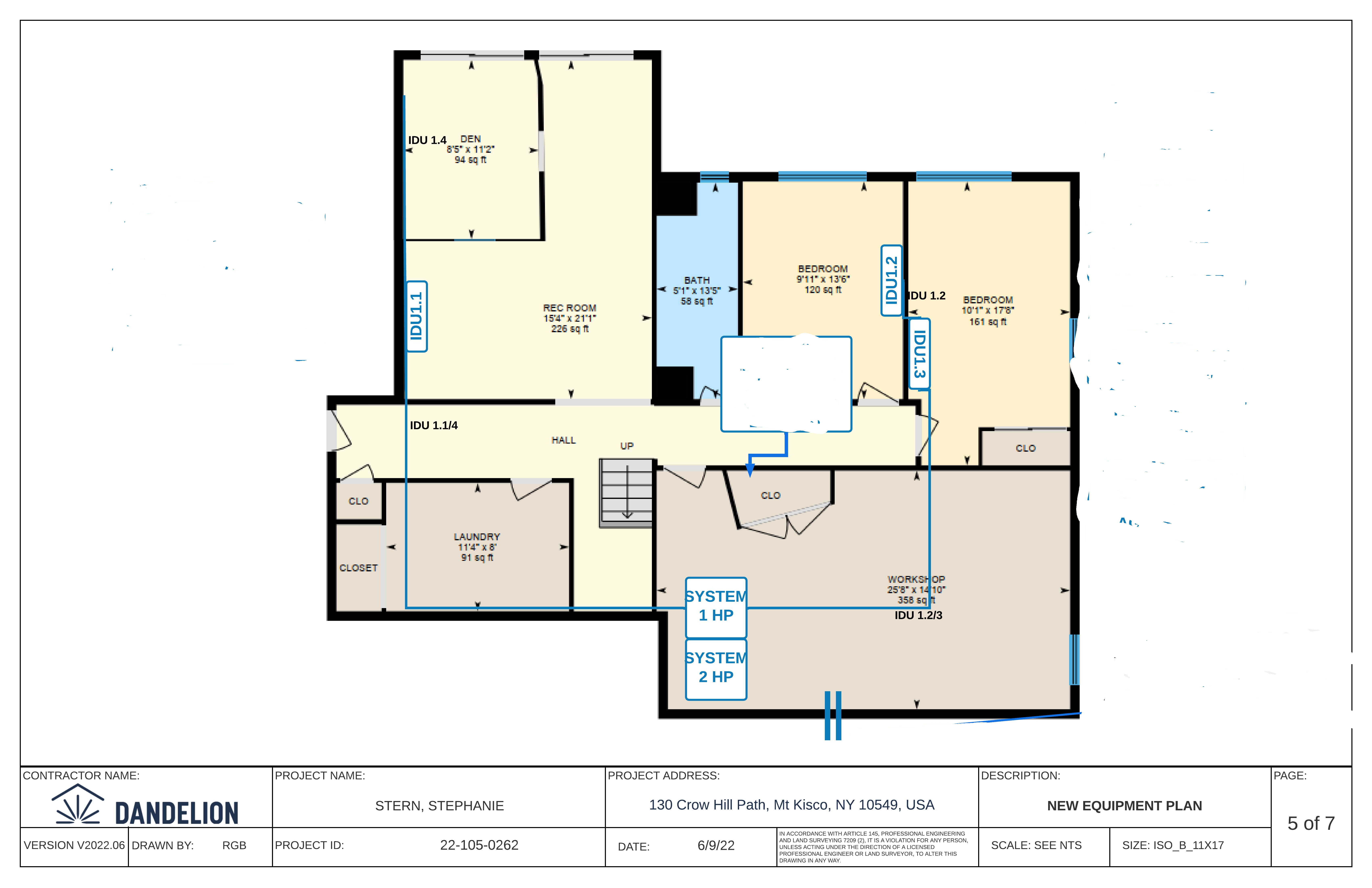
Installing the System
Due to the number of people who were signing contracts they had a back log of work. But in April of 2023 they arrived to begin drilling the wells.
Drilling the Wells
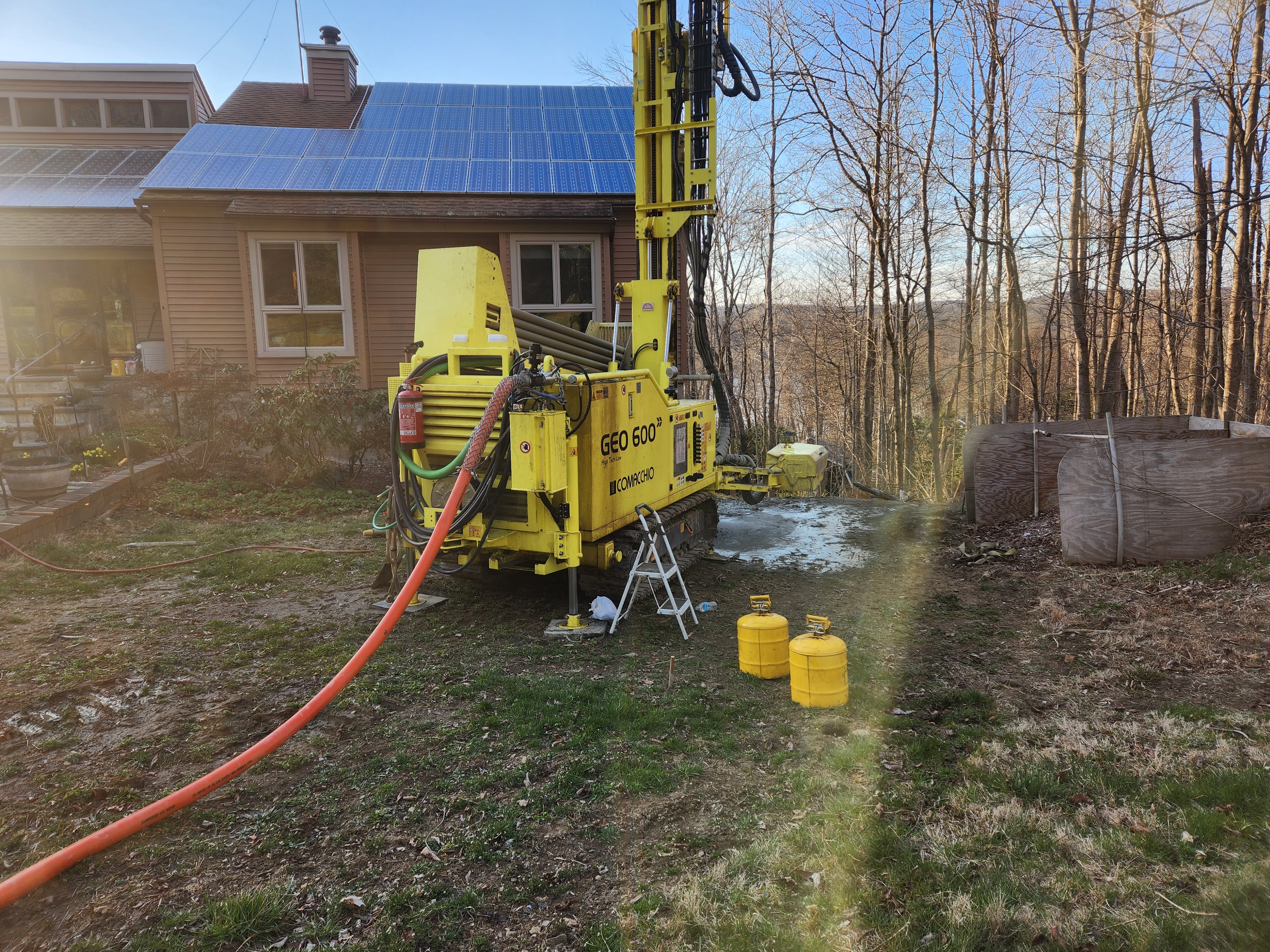
They drove the drill across my lawn to the location chosen for the 3 - 287 ft deep wells. Into each well they placed pipes going up and down so water or glycol could circulate through the pipes. Here is the specifications for the wells.

It was a bit of a mess during the drilling but they hailed away the rock from the drilling and left the place looking reasonable.
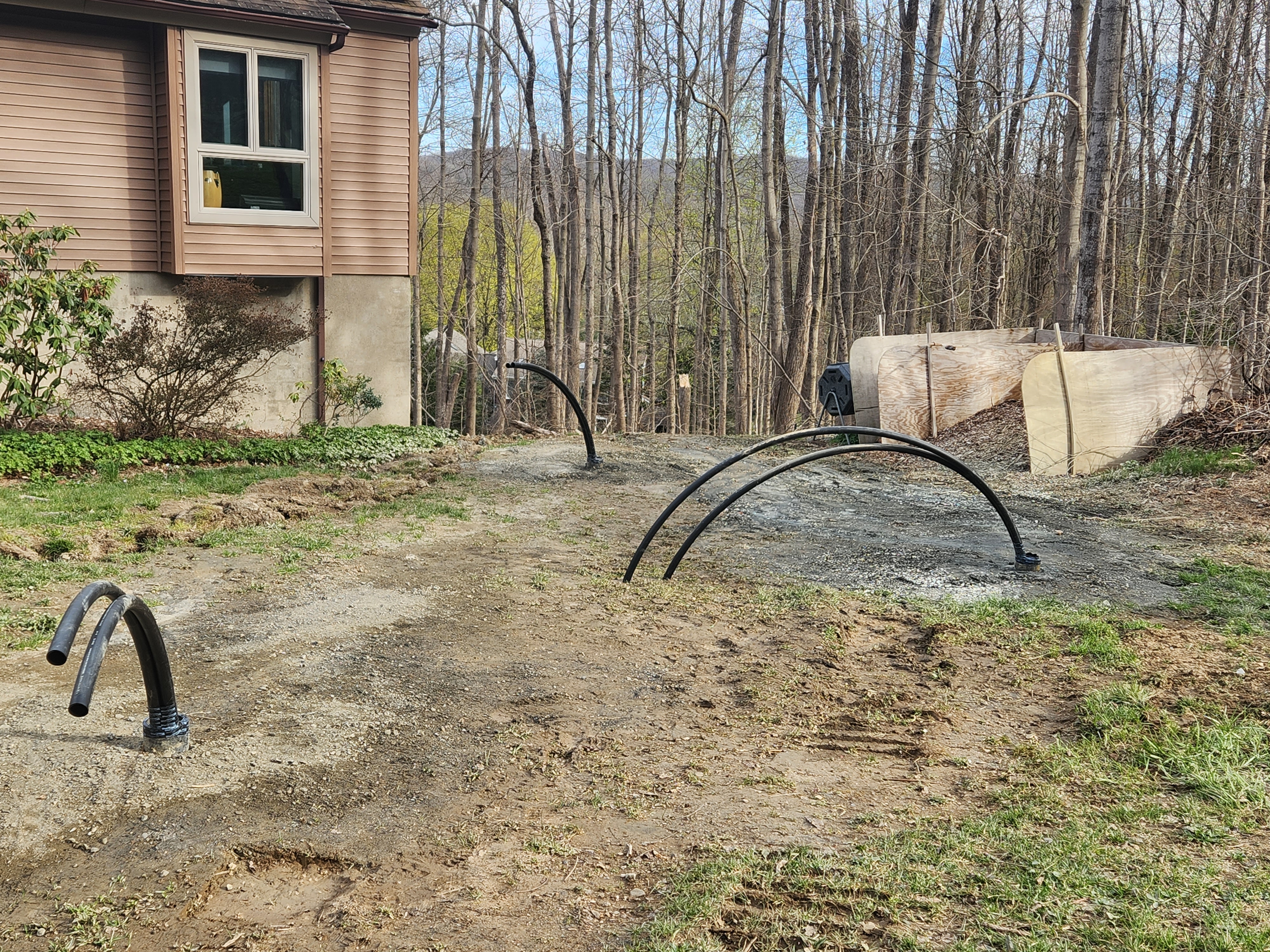
Trenching the pipes
Once the wells were done a different team came in to run the well pipes into the house.
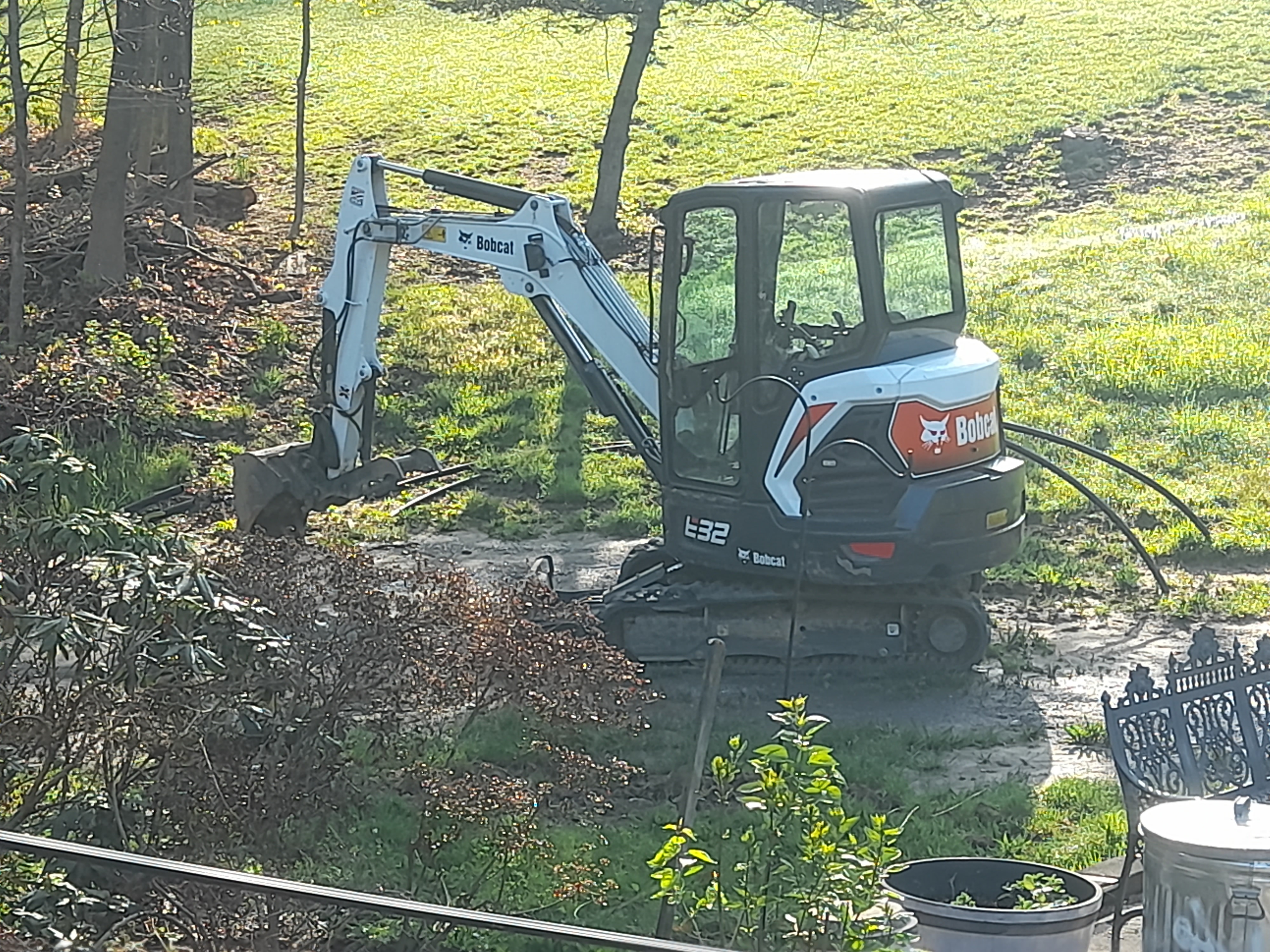
The next step is to connect the pipes from the wells into a single set of buried pipes and bring them into the house.
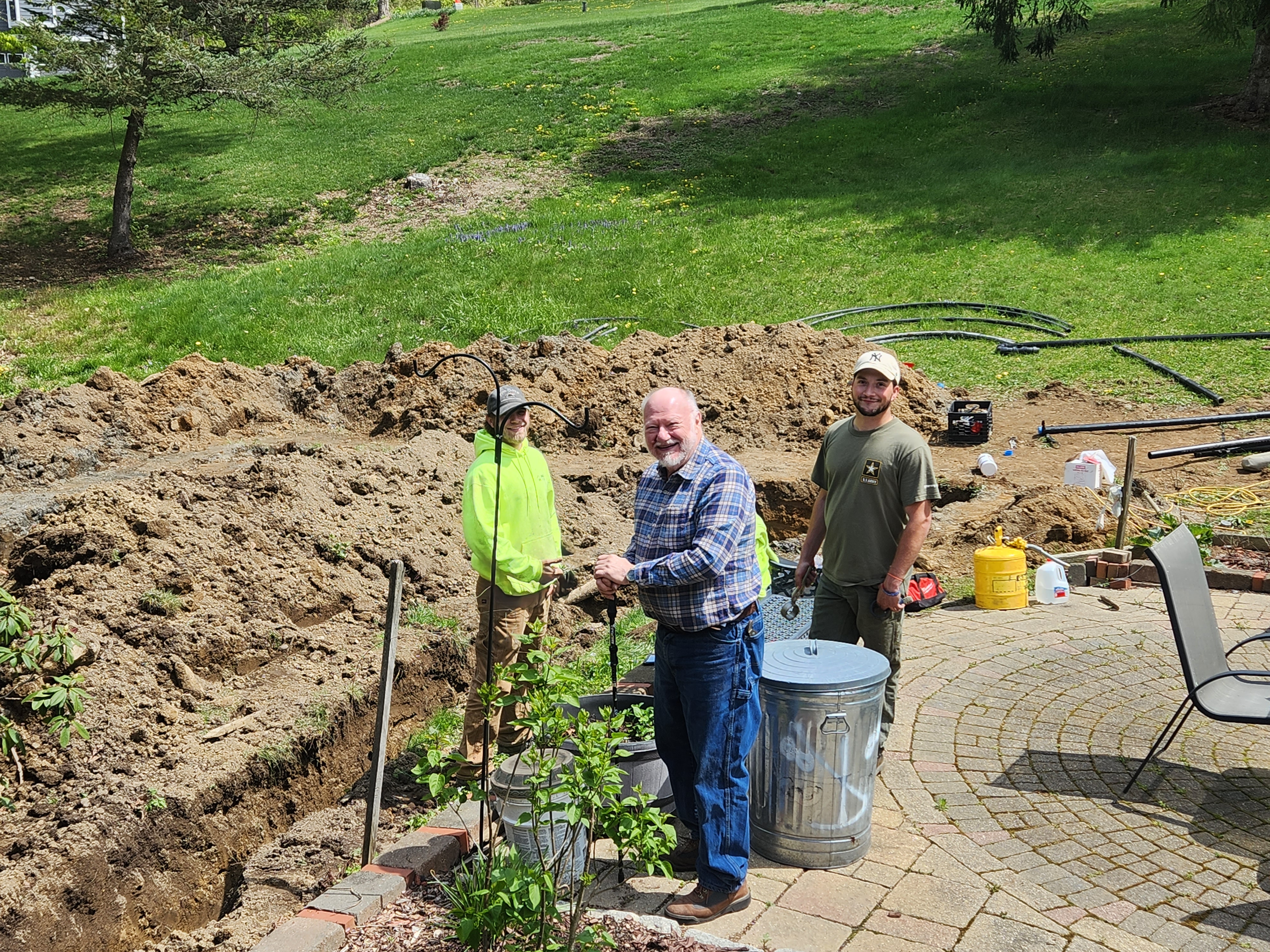
The well pipes are connected to two junction boxes. One side in outlet and the other inlet. The liquid is pumped into the inlet box, goes through the well, and returns to the outlet box. The boxes are then connect to two pipes that go through the wall of the house into the utility room. Once they are done they leveled the ground and left it to be reseeded.

Finally in October of 2023, the team arrived to install the system into the house. It took about 3 weeks to finish the install since they had to run both pipes and wires through the house.
Here is what the system in the wood shop/utility room looks like. First we have the pipes that run to and from the wells.

Next we have a 3 ton heat pump to provide heat and cooling for the 4 Ductless units around the house. These ductless units are mini air handlers for the individual rooms. Three downstairs and one in the library.
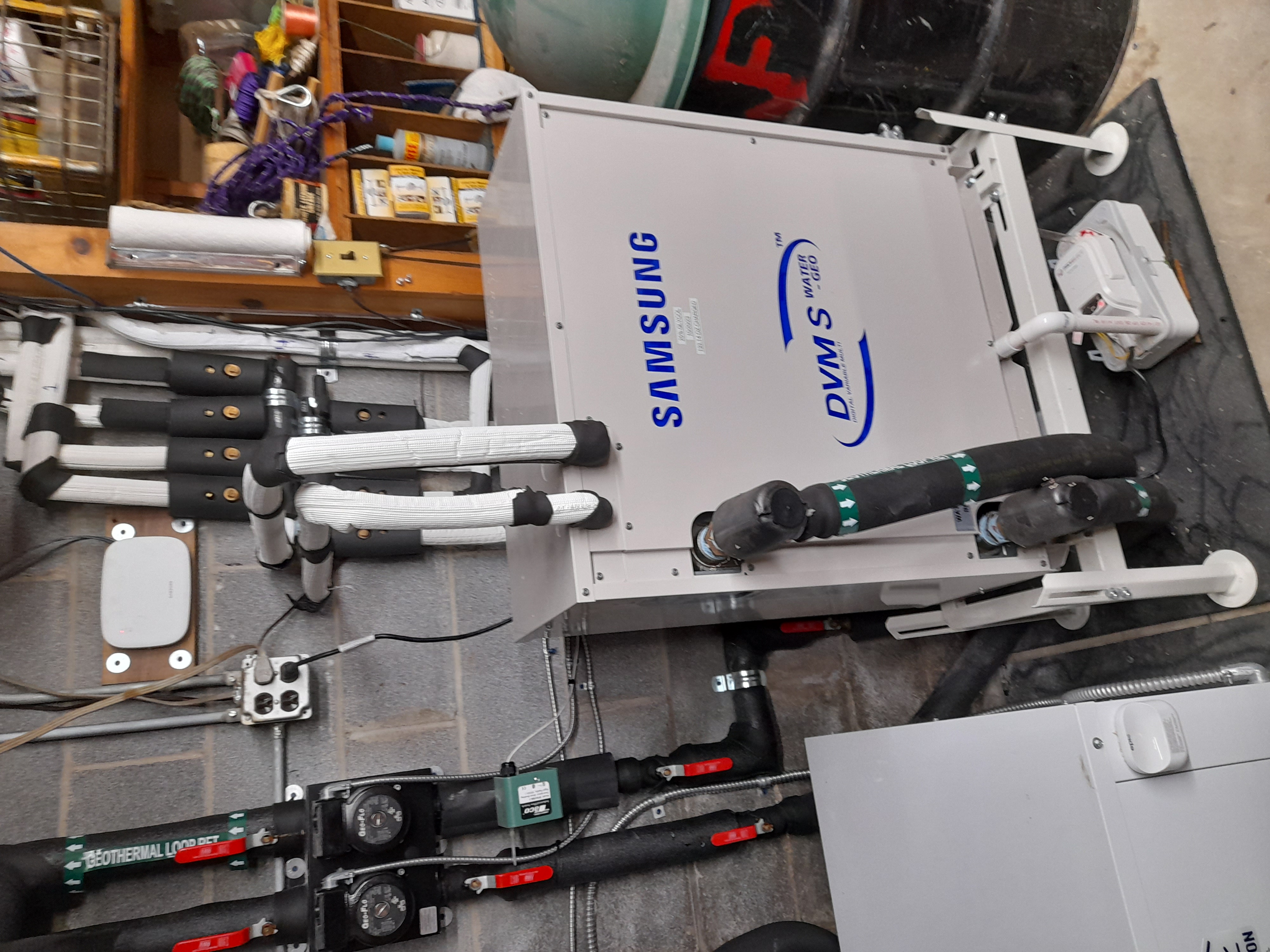
Lastly downstairs, we have the 5 ton unit that supplies the heat and cooling for most of the top floor.
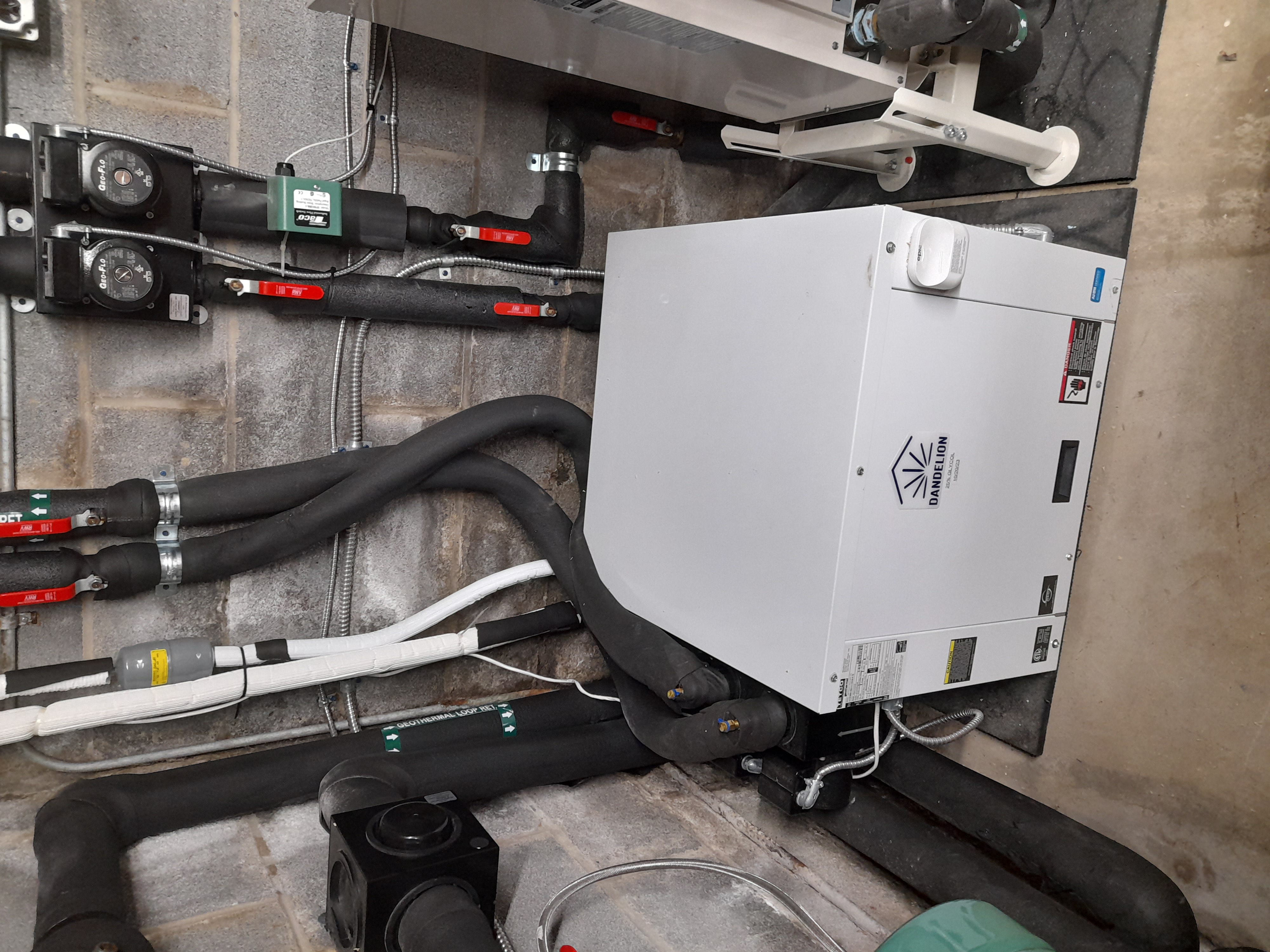
In the attic we have the air handler that drives the air in the ducts.
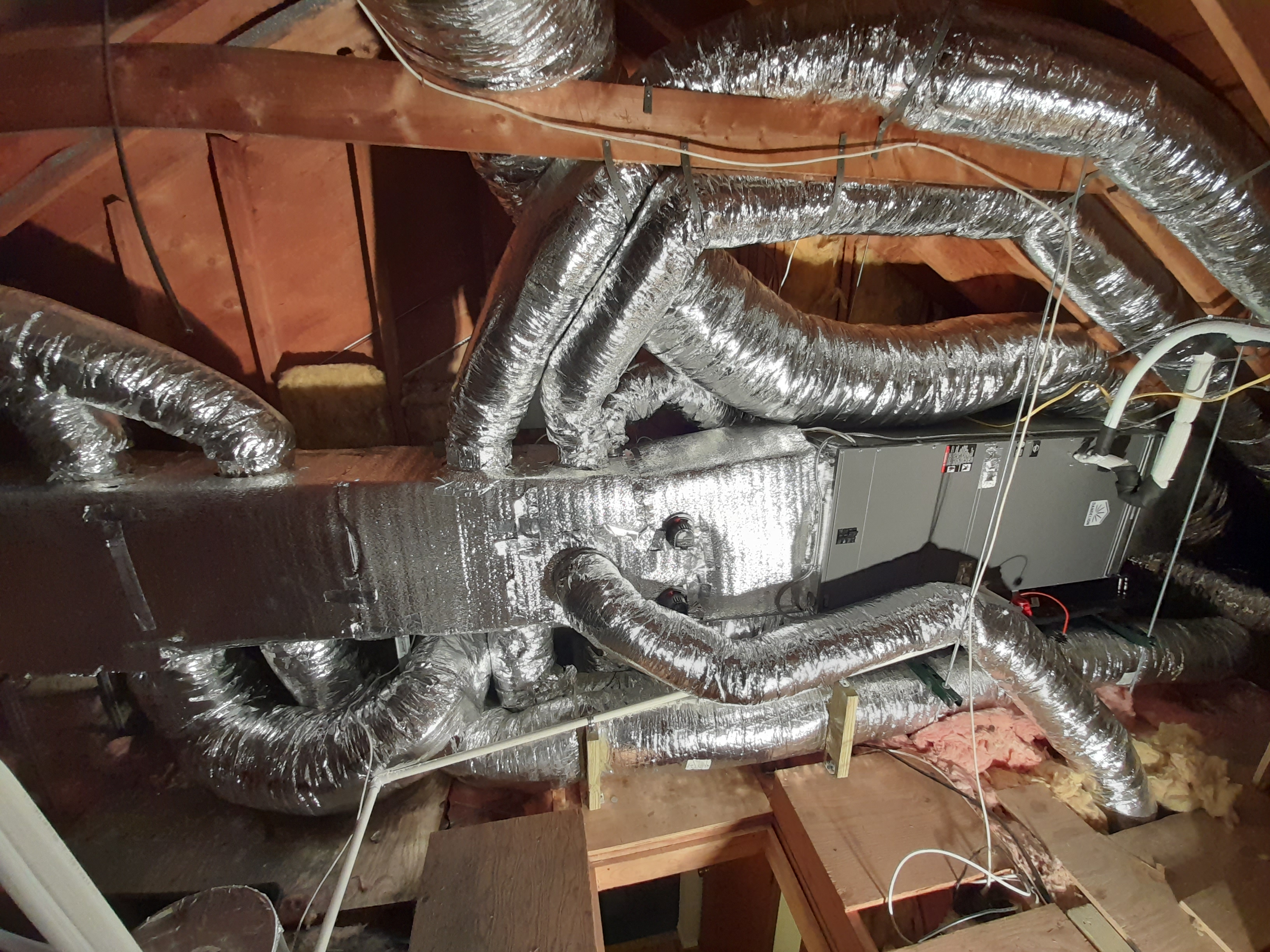
The air handler works with the 5 ton heat pump to heat/cool the air in most of the upstairs area.
Conclusion
The installation of the system went smoothly. But we still have a problem. Remember the 6 ton air source heat pump? Well it turns out the reason we had trouble during the hot weather is that it was only 3 tons not 6 as we thought. So this means that the duct work for each zone is only sized for 3 tons not six. When they put in the new system, they set up the system for only one zone since the duct work is only sized for 3 tons on each zone. This is a problem because the amount of heating and cooling for the main room is not adequate.
So as of today, 26 January 2024, I am still working with Dandelion to resolve the 2 zone issue. This will get fixed.
Written by John F. Moore
Last Revised: Sun Jan 28 03:31:23 PM EST 2024

This work is licensed under a Creative Commons Attribution-NonCommercial-ShareAlike 3.0 Unported License.
